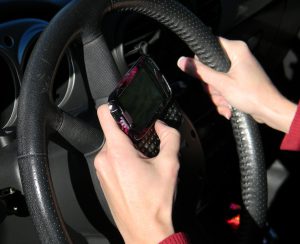 Driving to work this morning, I had to swerve to miss a driver who had crossed the center line. Thankfully, I was paying attention and he got back in his lane fairly quickly, so no one was hurt. I suspect the other driver never realized that he almost had a close encounter of the dangerous kind.
Driving to work this morning, I had to swerve to miss a driver who had crossed the center line. Thankfully, I was paying attention and he got back in his lane fairly quickly, so no one was hurt. I suspect the other driver never realized that he almost had a close encounter of the dangerous kind.
We’ve all heard the warning: driving while texting can be a deadly distraction. The problem is that most of us live fairly hectic lives. We may not intend to talk or text while we drive but the temptation to multi-task can be overwhelming – especially when we’re under a deadline. And honestly? Most of us think our driving skills are a shade above average and we can cope with a little distraction.
The hard truth is that cell phone use, especially texting, is “associated with the highest levels of driving performance degradation.” Even the most experienced texting driver takes twice as long to react, making texting a seriously dangerous activity. Around 69% of drivers, ages 18-64, report having used their phones while driving over the past 30 days. With over 9 people killed and 1,060 injured every day due to distracted driving, that’s a major problem.
So, what makes texting and driving so dangerous? You may have heard that the average texting driver takes his or her eyes off the road for an average of 5 seconds. At 55 mph, that’s like traveling the length of a football field blindfolded. What you may not know is that there are three distinct forms of driving distraction:
- Visual (requires driver to look away from the road)
- Manual (requires driver to take a hand or hands off the wheel to manipulate an object)
- Cognitive (thinking about something other than driving)3
According to the National Highway Traffic Safety Administration, texting is among the worst of driver distractions because it involves all three forms at the same time. With over 320 million cell phone subscriptions in the US today, it’s a problem that continues to grow.
Only you can make the decision to be an alert driver. Choosing to focus on your driving makes you better – and safer – while sharing the road.
Sources:
- Vegega, M., Jones, B., & Monk, C. (2013, December). Understanding the effects of distracted driving and developing strategies to reduce resulting deaths and injuries: A report to Congress (Report No. DOT HS 812 053). Washington, DC: National Highway Traffic Safety Administration.
- Cooper, J., Yager, C., Chrysler, S., (2011, August). An Investigation of the Effects of Reading and Writing Text-based Messages While Driving. Southwest Region University Transportation Center: Texas Transportation Institute.
- What Is Distracted Driving?, 2017, National Highway Traffic Safety Administration. http://nhtsa.gov/risky-driving/distracted-driving#34621.
 0
0
